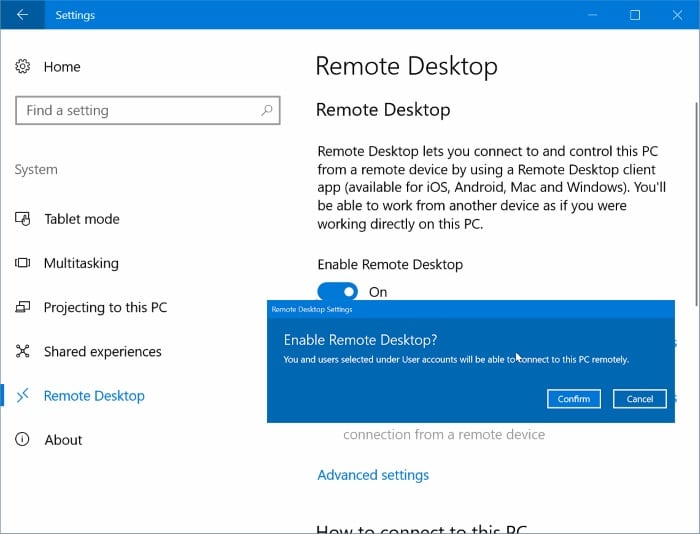Due to the fact that a Remote-Desktop-Connection always means to open your computer or server to the outside world, it is very important to consider potential security threats and weak points in your configuration. It is very important to choose strong passwords for every Remote-Desktop-Connection and you should consider introducing additional rules for your firewall.
Should connection difficulties arise, please check if your organization eventually deploys additional local firewalls. This may cause additional problems in your server-client connection and may need additional configuration.
Windows 10 provides two different ways to use a remote desktop, both of which need a VPN connection to the TU network to successfully connect via RDP.
Press "Start" and start typing "Remote" - the app will show up automatically.
Enter your IP-Address at "Computer" and the user name of the target device to connect.
Open the Microsoft-Store ("Start" → "Store") and install the "Microsoft Remote Desktop"-App.
The app will guide you step-by-step thru the connection of an RDP-Connection and allows you to easily store and manage several different connections as well as easily creating desktop shortcuts. You can also find the app directly via:
https://www.microsoft.com/en-gb/p/microsoft-remotedesktop/9wzdncrfj3ps?source=lp&activetab=pivot:overviewtab
If you want to allow incoming remote-desktop-connections on your PC you can do so by following these steps:
"Start" → "Settings" → "System" → "Remotedesktop" and click on "Remotedesktop aktivieren".
Please note the name of your computer in "How to connect to this PC" since you will need to enter this information in exactly this notation.
Alternatively, you can reach this point in your settings by clicking the following link (only with administrator rights):
ms-settings:remotedesktop?activationSource=SMC-IA-4028379
You can also use the Microsoft Remote Desktop Client in macOS. You will find a step-by-step tutorial from Microsoft via::
Deutsch:
https://docs.microsoft.com/de-at/windows-server/remote/remote-desktop-services/clients/remote-desktop-mac
Englisch:
https://docs.microsoft.com/en-us/windows-server/remote/remote-desktop-services/clients/remote-desktop-mac
Ubuntu supplies the Remote-Desktop-Client Remmina by default. A step-by-step tutorial to use Remmina can be found via:
Deutsch:
https://wiki.ubuntuusers.de/Remmina/
Englisch:
https://ubuntu.com/tutorials/access-remote-desktop#1-overview
RedHat does not supply an RDP client by default but provides excellent tutorials for using their recommended software Vinagre that can be found here:
Englisch:
Kurzanleitung - https://www.redhat.com/sysadmin/accessing-remote-desktops
Ausführliche Anleitung - https://access.redhat.com/documentation/en-us/red_hat_enterprise_linux/8/html/using_the_desktop_environment_in_rhel_8/accessing-the-desktop-remotely_using-the-desktop-environment-in-rhel-8
Configuring Remote Desktop Services can be done in the Server Manager ("Local Server" → "Remote Desktop Connection") or in the Settings ("System Settings" → "Security" → "System" or by typing "System" after pressing "Start"). Click on "Remote Settings" on the left, chose the "Remote"-tab, and enable "Allow remote connections to this Computer". Please also click on on "Select Users" to select the users that will have permission to connect to this machine.
The corresponding firewall rules will be activated and configured after enabling Remote Desktop. Should problems arise with connecting to this machine, a recommended first step is to check if those were set correctly, especially the following two rules which can be found at "Incoming Rules":
- Remote Desktop – User Mode (TCP-In)
- Remote Desktop – User Mode (UDP-In)
Important
Using this way of remote access allows - depending on the model of your Windows server - access to only 2 simultaneous Remote-Desktop-Connections. If you need more connections at the same time we recommend using the server role "Terminal Server", which will allow you far more ways of configuration and simultaneous connections. A tutorial for configuring a terminal server can be found on the following page, far more extensive tutorials for every possible use-case are available on the internet:
https://docs.microsoft.com/en-us/troubleshoot/windows-server/remote/install-and-configure-the-external-connector
Please note that using a Terminal Server requires a specific license. This can be acquired for a minimal fee directly via: https://oase.it.tuwien.ac.at/909469.asHTML


